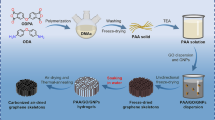Abstract
Poly(4,4'-oxydiphenylene pyromellitimide) (PMDA/ODA) hollow fiber membranes with regular morphologies have been successfully prepared through a two-step dry-jet wet spinning method. The morphologies of polyimide (PI) hollow fibers were regulated via adjusting the major spinning parameters, including dope/bore flow rate ratio, bore fluid composition, coagulation bath temperature and air gap distance. SEM results show that the morphologies of PI hollow fibers strongly depended on the spinning conditions, and fibers with regular asymmetric structures were finally obtained. The fiber wall thickened with the increase of dope/bore flow rate ratio, and the fibers could well self-support when the dope/bore flow rate ratio ranged from 3:1 to 4:1. While higher DMAc content in the bore fluid was conducive to the formation of finger-like voids, reduced amount of DMAc would result in smaller finger-like voids and thereby lower overall porosities as well as better mechanical properties. Moreover, the finger-like voids and surface defects could be effectively prevented by lowering the coagulation bath temperature or extending the air gap distance. Gas separation and mechanical properties of the hollow fibers were found closely related to these morphological changes. On such basis, regular PI hollow fibers with different microstructures and Young’s modulus up to 1040 MPa were successfully fabricated. The prepared polyimide hollow fibers are promising candidates for fine separation under high temperature and high pressure or can be employed as the support of composite membranes.
Similar content being viewed by others
References
N. Peng, N. Widjojo, P. Sukitpaneenit, M. M. Teoh, G. G. Lipscomb, T. S. Chung, and J. Y. Lai, Pro. Polym. Sci., 37, 1401 (2012).
P. Bernardo, E. Drioli, and G. Golemme, Ind. Eng. Chem. Res., 48, 4638 (2009).
R. Baker, Membr. Technol., 138, 5 (2002).
W. F. Yong, F. Y. Li, Y. C. Xiao, T. S. Chung, and Y. W. Tong, J. Membr. Sci., 443, 156 (2013).
L. Xu, C. Zhang, M. Rungta, W. Qiu, J. Liu, and W. J. Koros, J. Membr. Sci., 459, 223 (2014).
T. S. Chung, S. K. Teoh, and X. D. Hu, J. Membr. Sci., 133, 161 (1997).
G. Bakeri, A. F. Ismail, M. Rahimnejad, T. Matsuura, and D. Rana, Sep. Purif. Technol., 99, 262 (2012).
P. Li, H. Z. Chen, and T. S. Chung, J. Membr. Sci., 434, 18 (2013).
M. Khayet, Chem. Eng. Sci., 58, 3091 (2003).
S. P. Sun, K. Y. Wang, D. Rajarathnam, T. A. Hatton, and T. S. Chung, AIChE Journal, 56, 1481 (2010).
F. Falbo, F. Tasselli, A. Brunetti, E. Drioli, and G. Barbieri, Braz. J. Chem. Eng., 31, 1023 (2014).
X. Jie, Y. Cao, J. Qin, J. Liu, and Q. Yuan, J. Membr. Sci., 246, 157 (2005).
H. Z. Chen, Z. Thong, P. Li, and T. S. Chung, Int. J. Hydrogen. Energ., 39, 5043 (2014).
Y. Xiao, B. T. Low, S. S. Hosseini, T. S. Chung, and D. R. Paul, Pro. Polym. Sci., 34, 561 (2009).
D. J. Liaw, K. L. Wang, Y. C. Huang, K. R. Lee, J. Y. Lai, and C. S. Ha, Pro. Polym. Sci., 37, 907 (2012).
T. S. Chung and E. R. Kafchinski, J. Appl. Polym. Sci., 65, 1555 (1996).
G. C. Kapantaidakis, G. H. Koops, and M. Wessling, Desalination, 144, 121 (2002).
N. Widjojo and T. S. Chung, Ind. Eng. Chem. Res., 45, 7618 (2006).
N. Peng and T. S. Chung, J. Membr. Sci., 310, 455 (2008).
A. Ghosh, S. K. Sen, S. Banerjee, and B. Voit, RSC Adv., 2, 5900 (2012).
M. Zhang, H. Niu, and D. Wu, Macromol. Rapid. Commun., e1800141 (2018).
T. Kaneda, T. Katsura, K. Nakagawa, and H. Makino, J. Appl. Polym. Sci., 32, 3151 (2010).
J. Peterse, M. Matsuda, and K. Haraya, J. Membr. Sci., 131, 85 (1997).
C. Ba and J. Economy, J. Membr. Sci., 363, 140 (2010).
M. Kim, G. Kim, J. Kim, D. Lee, S. Lee, J. Kwon, and H. Han, Micropor. Mesopor. Mat., 242, 166 (2017).
S. Kim, S. H. Han, and Y. M. Lee, J. Membr. Sci., 403-404, 169 (2012).
Y. Li, B. Cao, and P. Li, J. Membr. Sci., 544, 1 (2017).
Y. Li, B. Cao, and P. Li, Appl. Surf. Sci., 473, 1038 (2019).
G. Bakeri, A. F. Ismail, M. Rahimnejad, T. Matsuura, and D. Rana, Sep. Purif. Technol., 98, 262 (2012).
M. R. Kosuri and W. J. Koros, J. Membr. Sci., 320, 65 (2008).
D. Wang, K. Li, and W. K. Teo, J. Membr. Sci., 115, 85 (1996).
W. S. Zheng and Y. J. Lan, Chem. Eng. Sci., 101, 130 (2013).
G. J. Dahe, R. S. Teotia, and J. R. Bellare, J. Appl. Polym. Sci., 124, 134 (2011).
X. Liu, B. Cao, and P. Li, Ind. Eng. Chem. Res., 57, 329 (2017).
Acknowledgments
The authors greatly thank the financial support from National Key Research and Development Program of China (Project No.2017YFB0307600).
Author information
Authors and Affiliations
Corresponding authors
Rights and permissions
About this article
Cite this article
Xiao, M., Li, J., Lei, H. et al. Preparation and Microstructure Control of PMDA/ODA Polyimide Hollow Fibers. Fibers Polym 21, 944–953 (2020). https://doi.org/10.1007/s12221-020-9381-2
Received:
Revised:
Accepted:
Published:
Issue Date:
DOI: https://doi.org/10.1007/s12221-020-9381-2




